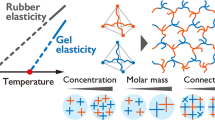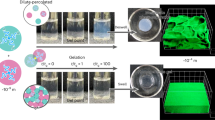Abstract
PHASE transitions and critical phenomena in polymer gels have attracted much attention because of their scientific interest and technological significance1–3. Phase transitions accompanied by a reversible, discontinuous volume change as large as several hundred times, in response to infinitesimal changes in environmental conditions, have been observed universally in gels made of synthetic and natural polymers1–9. Phase transitions have been induced in gels by varying temperature, solvent composition, pH, ionic composition and a small electric field10. Recently, gels sensitive to ultraviolet light were also reported11. The ultraviolet light initiates an ionization reaction in the gel, creating internal osmotic pressure which induces swelling. In the absence of this light, the equilibrium tends towards the neutral polymer system and the gel collapses. This transition process is slow, as it depends on the photochemical ionization and subsequent recombination of ions, and it is technologically desirable that the transition be induced by faster mechanisms. Also, visible light is less harmful and more abundant than ultraviolet in sunlight. Hence we now report the phase transition of gels induced by visible light, where the transition mechanism is due only to the direct heating of the network polymers by light, which is an extremely fast process. Such systems might be used as photoresponsive artificial muscles, switches and memory devices.
This is a preview of subscription content, access via your institution
Access options
Subscribe to this journal
Receive 51 print issues and online access
$199.00 per year
only $3.90 per issue
Buy this article
- Purchase on Springer Link
- Instant access to full article PDF
Prices may be subject to local taxes which are calculated during checkout
Similar content being viewed by others
References
Tanaka, T. Phys. Rev. Lett. 40, 820–823 (1978).
Dusek, K. & Patterson, D. J.Polym. Sci. A2–6, 1209–1216 (1968).
Tanaka, T. et al. Phys. Rev. Lett. 45, 1636–1639 (1980).
llavsky, M. Macromolecules 15, 782–788 (1982).
Hrouz, J., llavsky, M., Ulbrich, K. & Kopecek, J. Eur. Polym. J. 17, 361–367 (1981).
Hirokawa, Y. & Tanaka, T. J. chem. Phys. 81, 6379–6380 (1984).
Erman, B. & Flory, P. J. Macromolecules 19, 2342–2350 (1986).
Hirotsu, S., Hirokawa, Y. & Tanaka, T. J. chem. Phys. 87, 1392–1395 (1987).
Amiya, T. & Tanaka, T. Macromolecules 20, 1162–1164 (1987).
Tanaka, T., Nishio, I., Sun, S-T. & Ueno-Nishio, S. Science 218, 467–469 (1982).
Mamada, A., Tanaka, T., Kungwatchakun, D. & Irie, M. Macromolecules 23, 1517–1519 (1990).
Flory, P. J. Principle of Polymer Chemistry (Cornell University Press, 1953).
Li, Y. & Tanaka, T. J. chem. Phys. 92, 1365–1371 (1990).
Tanaka, T. & Fillmore, D. J. J. chem. Phys. 70, 1214–1218 (1979).
Author information
Authors and Affiliations
Rights and permissions
About this article
Cite this article
Suzuki, A., Tanaka, T. Phase transition in polymer gels induced by visible light. Nature 346, 345–347 (1990). https://doi.org/10.1038/346345a0
Received:
Accepted:
Issue Date:
DOI: https://doi.org/10.1038/346345a0
This article is cited by
-
A concise review on bio-responsive polymers in targeted drug delivery system
Polymer Bulletin (2023)
-
Large deflection of a bilayer soft strip due to incompatibility of isotropic volumic expansion
Acta Mechanica Sinica (2023)
-
Fiber-Shaped Soft Actuators: Fabrication, Actuation Mechanism and Application
Advanced Fiber Materials (2023)
-
Interaction of Light with Different Electroactive Materials: A Review
Journal of Electronic Materials (2022)
-
Thermo-responsive release of rhodamine B in the pore-selective poly(N-isopropylacrylamide) immobilized honeycomb-patterned porous film
Polymer Bulletin (2022)
Comments
By submitting a comment you agree to abide by our Terms and Community Guidelines. If you find something abusive or that does not comply with our terms or guidelines please flag it as inappropriate.



